- Diameters Offered: 27.5’’ and 29’’
- Stated Width: 2.5’’ and 2.6’’ options
- Versions Offered: Trail Pro and Gravity Pro casings; Addix Soft and Addix Ultra Soft rubber
- Blister’s Measured Width: 2.28‘’ (casing) / 2.42’’ (tread)
(Albert Trail Pro 2.5’’ on 30 mm internal-width rim) - Blister’s Measured Weight (Albert Trail Pro 2.5’’ Ultra Soft, 29’’ diameter): 1,155 and 1,166 g
- MSRP: $104
- Diameter Offered: 29’’
- Stated Width: 2.5’’
- Version Offered: Gravity Pro casing; Addix Ultra Soft rubber
- MSRP: $104
- Diameters Offered: 27.5’’ and 29’’
- Stated Width: 2.5’’
- Version Offered: Gravity Pro casing; Addix Ultra Soft rubber
- MSRP: $104
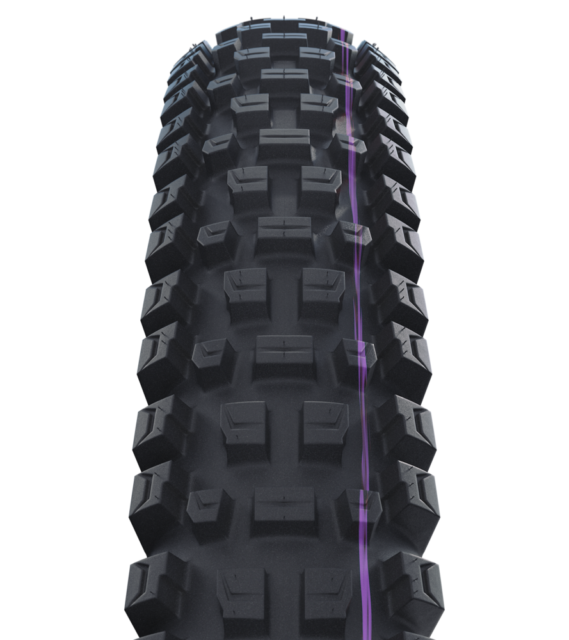
Intro
It’s common for tire companies to offer a few different casing options within their lineups, generally trading off weight for sidewall support and puncture protection, and the differences there are pretty easy to get your head around. Heavier tires typically offer better support and protection, whereas going lighter often reduces a tire’s performance in those regards. But despite their importance, tweaks to tire casing construction don’t usually come with much fanfare.
However, Schwalbe has come up with something that they claim is a genuine sea change in how bike tires are constructed, and launched a couple of new tread patterns to go along with it. Let’s check out their new radial casing construction and how it’s implemented into their new Albert and Shredda tires.
Radial Casing Design
The core of the radial casing concept is deceptively simple. Schwalbe is simply changing the angles of the threads that make up the casing layers of tires, both in terms of their orientation within the tire, and the angles at which they cross each other.
In a more conventionally constructed tire, the individual threads that make up each woven casing layer are oriented at roughly a 45° angle to the centerline of the tire, and cross each other at ~90° angles (which is known as “bias ply” construction).
In Schwalbe’s radial construction, they’re positioned at a much shallower angle (i.e., closer to being perpendicular to the centerline of the tire). It’s easier to explain visually:
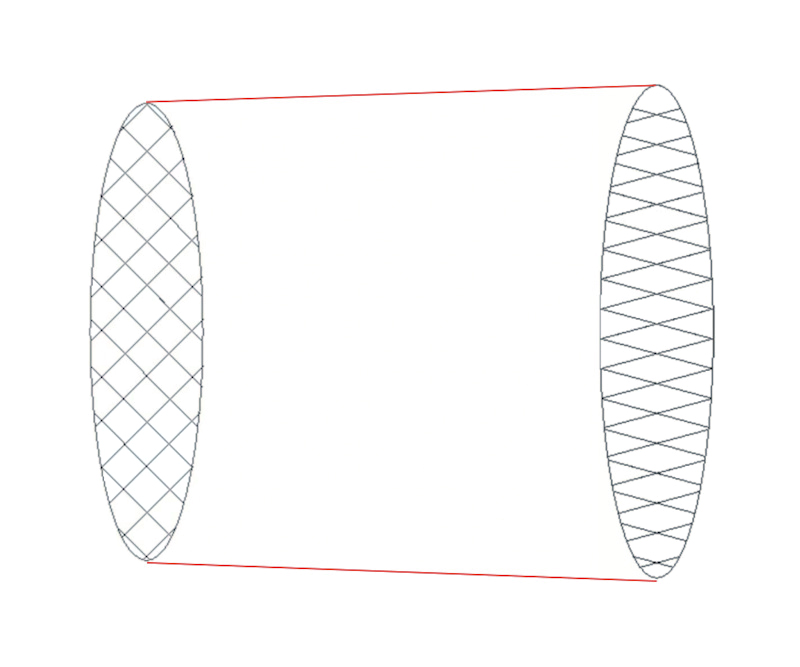
Radial car tires are commonplace, but those orient the plies fully perpendicular to the tire centerline, and thus require a belt down the middle of the tread to support the casing. By that definition, Schwalbe’s new tires aren’t truly radial, but by having plies that still cross each other (just at a much shallower angle than normal), they’re able to forgo the belt that classic radial tires require.
Schwalbe’s casing plies still use 67 threads per inch, same as in their standard tires — they’re just oriented differently here. Playing with ply angles (including true radial construction, as in Maxxis’ Radiale road tire) isn’t new in bike tires, either, but Schwalbe is pushing them much further than most implementations.
The idea is to make the casing more able to deform and consequently follow smaller contours in the trail, and to offer a larger contact patch at a given tire pressure. This ply orientation opens wider gaps between the points at which the casing threads cross along the width of the tire, so the casing is meant to be more pliable along that axis. The spacing between thread crossings does tighten up along the centerline of the tire, but the casing is inherently more pliable in that direction since it’s less supported by the sidewalls, so the end result is (allegedly) a much more supple casing overall.
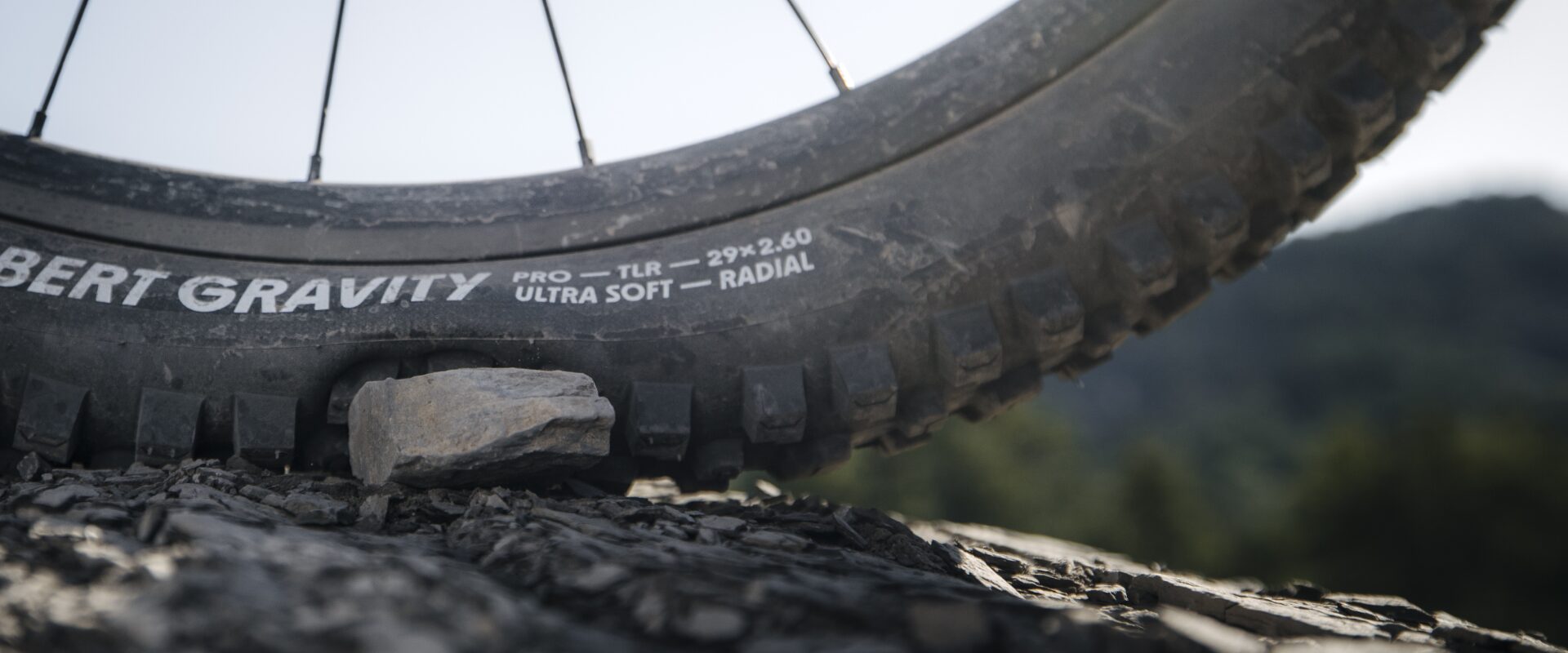
Allowing the tire casing to deform more readily on a small scale can, in theory, keep more knobs in contact with the ground in more situations. Schwalbe says the radial construction results in a tire that both offers more grip and rides more smoothly due to the tire’s increased ability to conform to small bumps and terrain irregularities.
To put some numbers to those claims, Schwalbe says that the new radial construction produces a 30% larger contact patch at a given air pressure than their standard construction. Even with the pressure increased by 50%, the radial tire is claimed to have a 15% larger contact area. Schwalbe recommends starting at a similar pressure to what you’d run in a conventional tire of similar construction but says that the more supple casing leaves more room to adjust ride feel and performance by varying pressure, rather than needing to operate in a more constrained pressure range to maintain good grip.
Schwalbe also admits that the increased casing flexibility does increase rolling resistance slightly, but says that a lot of folks will be able to make up for that by running more air pressure and/or faster-rolling tread patterns due to the increased grip that the more pliable casing offers.
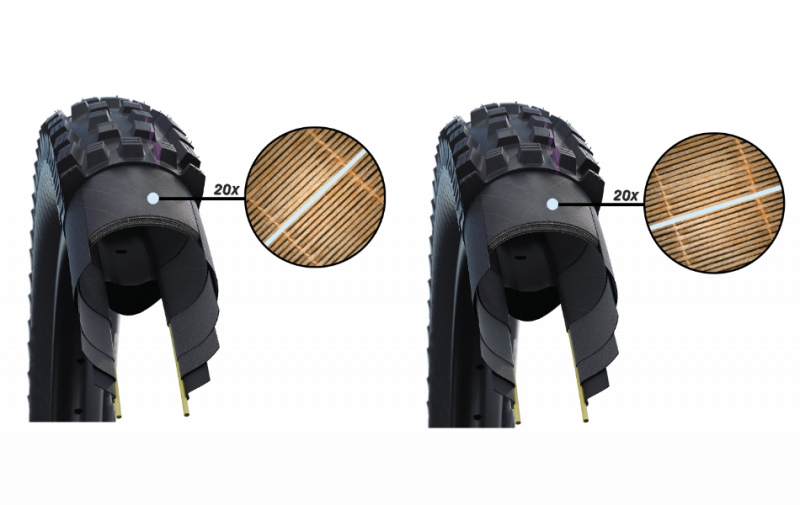
For the time being, Schwalbe is offering radial casings in two versions — straightforwardly named Trail Pro and Gravity Pro — which correspond to their SuperTrail and SuperGravity bias-ply tires in terms of weight and toughness.
So far, Schwalbe offers the Trail Pro and Gravity Pro construction in the Magic Mary (the tread pattern for which is unchanged) and two new designs — the Albert and the Shredda (the latter of which comes in separate front and rear versions).
Schwalbe Albert Tire
The new Albert is meant to be a versatile all-rounder tire for a range of conditions, and Schwalbe says that its tread pattern is designed specifically for the new radial construction. Unlike the Magic Mary, which is still available with more conventional casings, the Albert is only offered in Trail Pro and Gravity Pro (i.e., radial) constructions.
The Albert uses an alternating 3-2 center knob pattern with a single side knob shape, though the side knobs are positioned in more closely spaced pairs with a wider gap between pairs to open up space for the three-wide center knob rows. As is the case with a lot of Schwalbe’s tires, the side knobs are angled slightly so that the leading edge is set wider than the trailing one, and there’s a slight L-hook to them with the cupped portion pointing toward the leading edge.
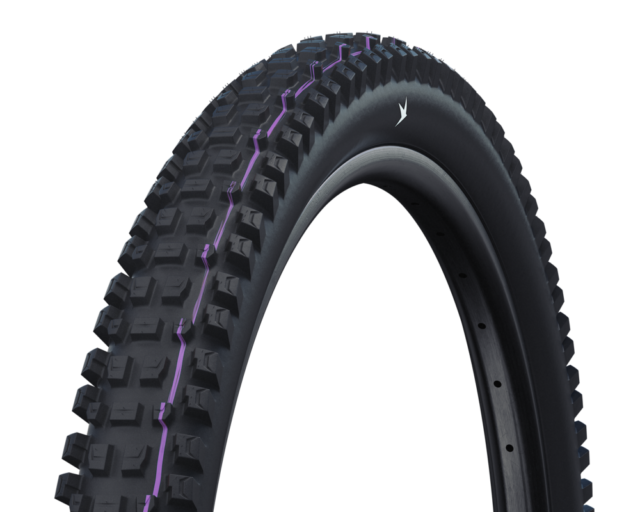
The design (the center knobs particularly) looks a bit like the Continental Kryptotal Front. Compared to the Kryptotal and many superficially similar designs (e.g., the Maxxis Assegai), the Albert’s knobs are relatively tightly spaced and not especially tall or spiky. Schwalbe says that was done, in part, to counterbalance the rolling resistance hit from the more flexible radial casings, and it’ll be interesting to see how the whole package comes together (you can check out our Flash Review for our initial impressions).
The Albert is available in 27.5’’ and 29’’ diameters, 2.5’’ and 2.6’’ widths, Addix Soft and Addix Ultra Soft rubber compounds, and Trail Pro and Gravity Pro casings. (Not every possible combination of those options is on offer, though; check out Schwalbe’s website for the details.)
Schwalbe Shredda Tires
The Shredda, on the other hand, is an especially spiky, aggressive tread pattern meant primarily for eMTBs in soft conditions. It uses separate tread patterns for the front and rear, with the Shredda Front using very spiky two-wide center knobs and widely spaced side knobs to more readily sink into softer dirt. The Shredda Rear uses an alternating 3-2 center knob arrangement like the Albert, but the Shredda Rear’s knobs are spikier and much more widely spaced, again to better penetrate softer dirt.
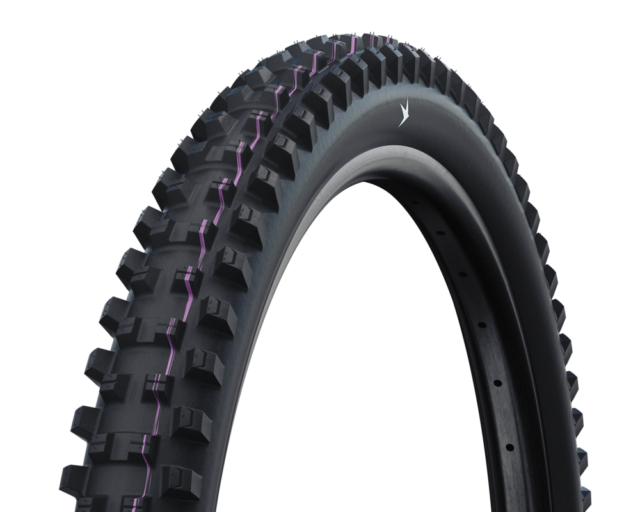
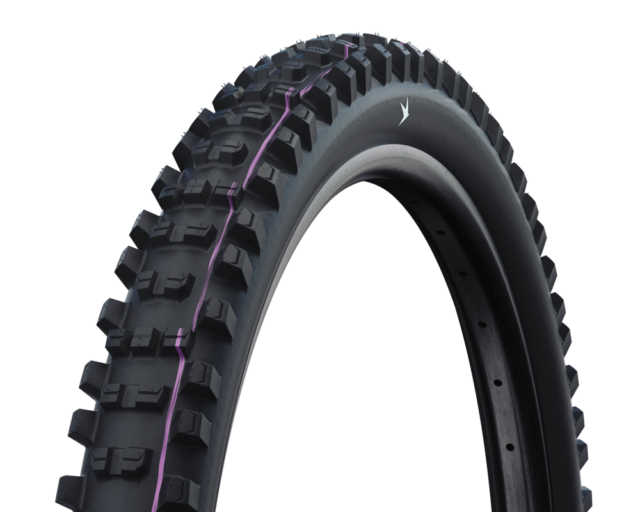
Bottom Line (For Now)
Schwalbe is talking a very big game about the performance of their new radial tire construction, and we’re quite curious to see how it’s borne out on the trail. We’ve started spending time on the new Albert Trail Pro tires to find out. Stay tuned.
Flash Review: Our Initial On-Trail Impressions
BLISTER+ members and those who purchase our Digital Access Pass can check out the Flash Review below to read our initial on-trail impressions. Get our Digital Access Pass to view all our Flash Reviews and Deep Dives, or become a BLISTER+ member today to get access to that and a LOT more, including the best worldwide Outdoor Injury Insurance, exclusive deals and discounts on skis, personalized gear recommendations from us, and much more.
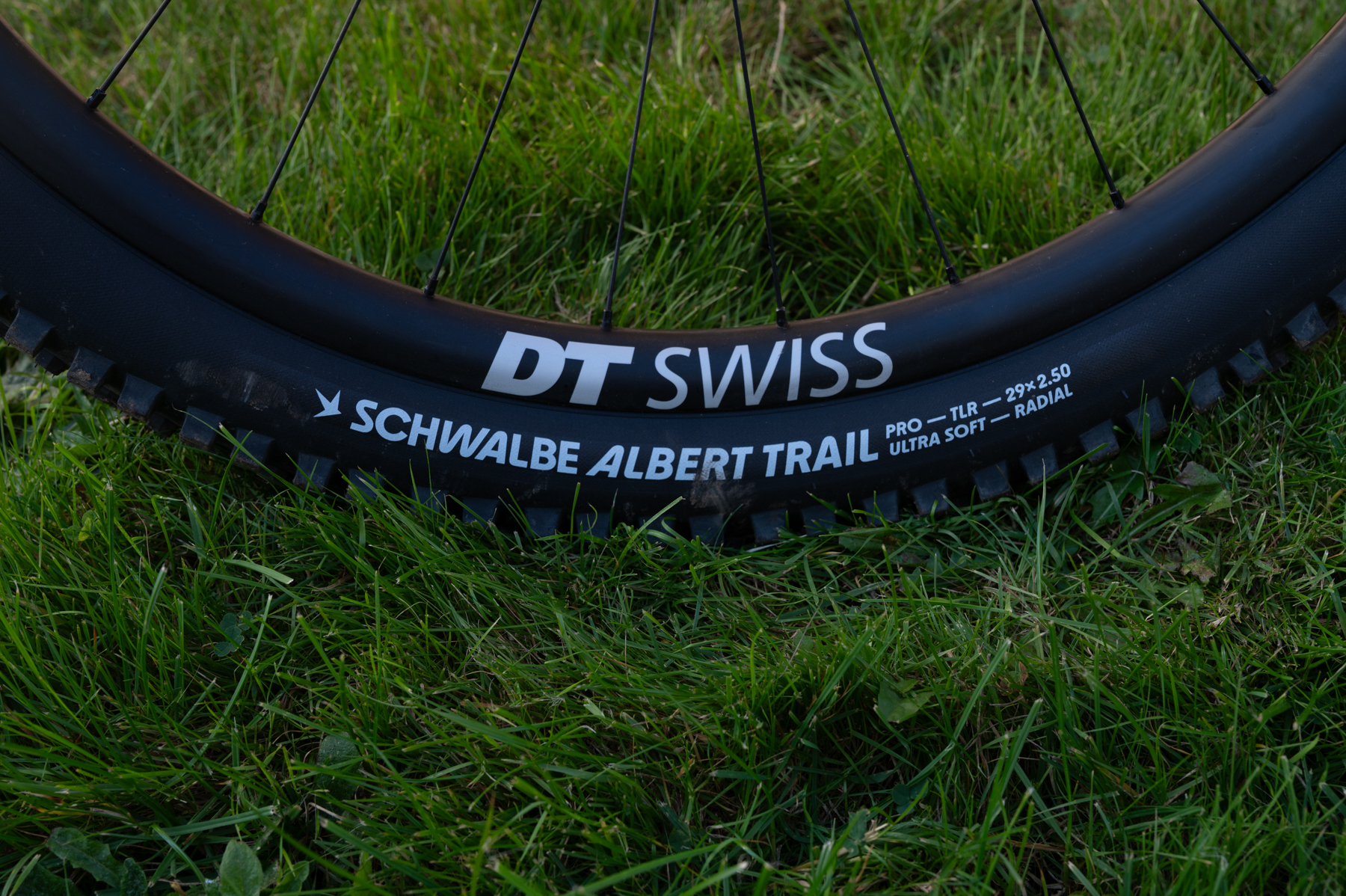
Flash Review — Schwalbe Albert Tires
Schwalbe says that their new radial casing tires offer a very different feel from more conventional tire constructions, and we’ve started to put those claims to the test. Here are our early impressions.
Blister’s Flash Reviews and Deep Dives are accessible to those who purchase one of our paid subscriptions
To get our comprehensive Deep Dives and our initial, unfiltered reports on new gear, become a member and receive many other services, deals, and discounts.
If you’re already an active member, please log in.
(If you’re already logged in and a member in good standing and seeing this message in error, please refresh this page in your browser.)
